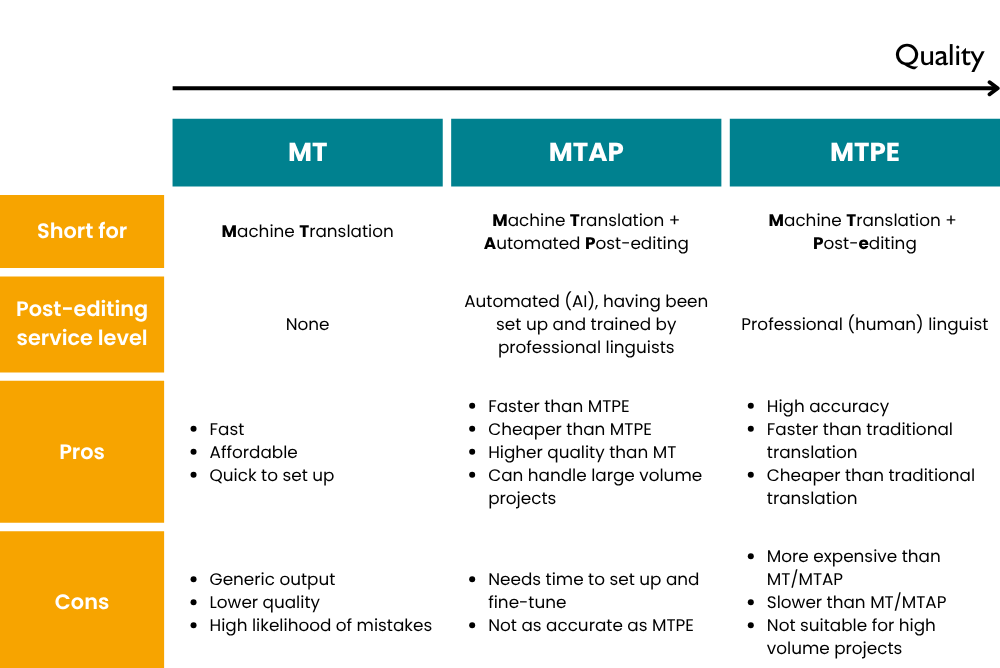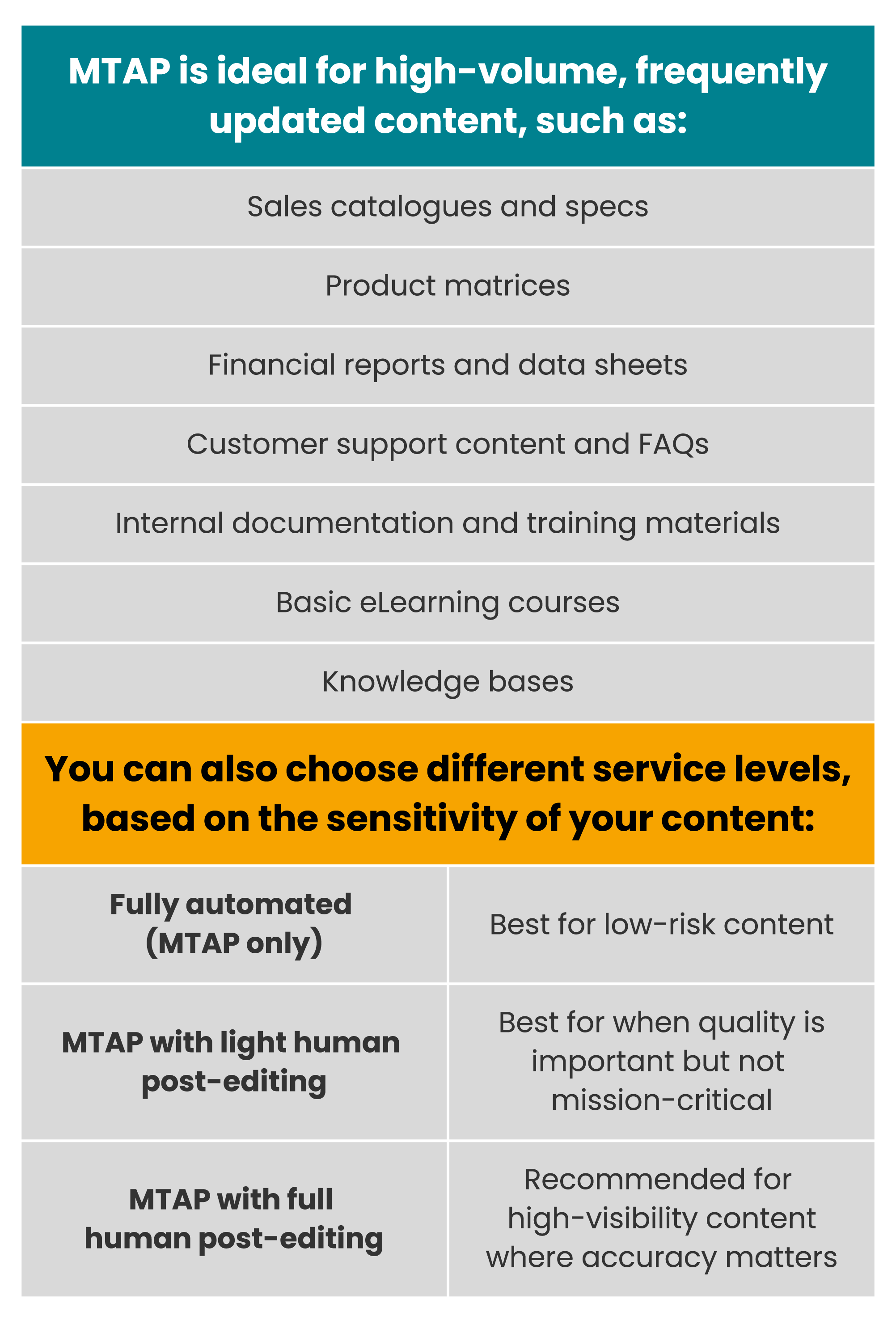Let’s be honest: translation never sleeps. The content keeps coming, the deadlines get tighter, and somehow, your budget and team haven’t doubled (how rude!).
If you’re trying to keep pace with growing volumes of multilingual content, these complaints will feel very familiar. From my vantage point of working agency-side, I hear about these struggles from almost every client.
That’s why we’re so excited to be offering MTAP as a (sort of) new localisation method. Short for customised Machine Translation + Automated Post-editing, it’s a clever little setup that helps you translate low-risk content, faster than ever, and without compromising your brand terminology (or sanity).
It’s not magic, and it’s not exactly new… But it’s hard not to be impressed when you see how it works and what it can do.
Why traditional translation methods don’t always cut it
Let’s rewind a bit. Most translation workflows used to fall into one of two camps: fully human or fully machine. And each has its pros and cons.
We love a beautifully crafted, fully human translation as much as the next linguaphile. But when you’re churning out hundreds of product descriptions or updating a support centre every week, it’s not always the most efficient route.
On the other hand, pure machine translation is fast but often a bit… off. It can sound clunky or robotic without a fair amount of editing and proofreading, or it can sound so generic that it just doesn’t reflect your brand. Sure, it can do the job at times, but it’s “good enough”, not “great”. And we’re aiming for “GREAT”, aren’t we?
That’s why the dev team at Comtec has spent a significant amount of time developing our MTAP solution and preparing it for market release. It sits in that sweet spot between quality and speed.
So, what is MTAP exactly?
It’s easiest to explain MTAP as a two-part process:
Step 1: Customised machine translation (MT)
We train a translation engine specifically for your brand, using your tone of voice, preferred terminology, and previous translations. This step sounds simple, but it’s actually quite involved; we take the time to source all your reference materials and language assets (such as glossaries, style guides, and examples of strongly branded content), then upload them ready for customising the machine translation engine.
Step 2: Automated post-editing (AP)
We then proceed with setting up the automated post-editing phase, applying all your preferred terminology, style, and tone of voice (i.e., the language assets you provided) to fully tailor the output. The result is content that’s even more refined, flows better, and is more in sync with how your brand actually sounds.
All of this is completely automatic (i.e., no humans are involved beyond the setup and testing stages).
Customised MT isn’t new, but automated post-editing is pretty cutting-edge. And pairing the two together? Well, that’s just a tiny bit genius (our tech team really is very, very good).
Wait, hang on – what’s the difference between MT, MTAP and MTPE?
It’s a fair question. The world of translation tech loves an acronym, and they can all sound fairly similar, not to mention a tiny bit dull.
So here’s a quick explainer:
- MT (Machine Translation): fast and cheap but usually “raw”. That means no editing, no finesse. So, it’s not ideal for anything customer-facing, as there’s a fair chance it might have some direct translations (translating my name, James Brown, into James “Marron” in Spanish, for example).
- MTAP (Machine Translation + Automated Post-editing): machine translation + clever AI-based editing. Professional linguists assist with setup and testing, but once it’s live, the day-to-day operations are fully automated.
- MTPE (Machine Translation + Post-Editing): machine translation with a professional linguist revising and editing the MT output to fix errors, smooth tone and make it sing. Better quality, so essential for customer-facing content.
Faster than MTPE and more polished than raw MT, think of MTAP as your efficient middle ground: AI translations built for scale, but still with a bit of personality and polish to them.

How MTAP makes life for localisation teams so much easier
We’ve been rolling MTAP out for a few months now, and here’s what our clients like about it:
- It’s quick. You get usable translations in minutes, not days.
- It’s affordable. Less human input = more budget for other priorities.
- It’s consistent. Once your brand rules are set, they’re applied every time.
- It’s flexible. Need human verification for certain elements? No problem.
We’re not saying MTAP is right for every situation. But for high volumes of low-risk content when speed is essential, it’s a very handy tool to have in your back pocket.

So, when is it a good idea to use MTAP?
If you’re in any of these situations, MTAP could make a big difference:
- You manage an eCommerce site with thousands of SKUs.
- You have product or user manuals that need to be translated into numerous languages.
- You have a giant financial report that needs to be localised.
- Your customer support content keeps evolving.
- You’re translating internal training for multiple markets.
- You’re looking for better than raw MT quality placeholder translations for your website, while professionals work on post-editing the content.
We’ve seen it work especially well in:
- Retail and eCommerce
- Software and tech
- Manufacturing and logistics
- Learning and development
Essentially, anywhere there is a lot of content and not enough time.
How can I start using MTAP?
There are a few different ways to bring MTAP into your workflow, depending on what suits your setup:
- Project-by-project basis: Ideal for one-off projects with a set start and end date or large content batches. We’ll manage the process for you, from setting up the MT engine to fine-tuning the prompts. We use our own expert linguists, set a benchmark with you, and you can specify how much sampling or spot-checking you want to do. Basically, you’re in control, but we do all the work.
- Pronto: This is the in-house version of MTAP. Pronto is our self-service MTAP platform, providing 24/7 access to your MT engine and post-editing prompts. You pay for it on a subscription basis. We set it up for you, train you on how to use it, and then we’re just a call away if you need help. This option is ideal for busy in-house teams that regularly require MTAP-quality content.
- Continuous localisation: If you publish content regularly (think websites, apps, support centres), we can integrate MTAP directly into your CMS or content systems. So, you’re running things in-house, and the setup lets you publish your MTAP content seamlessly anywhere you need to. It’s hands-off, fully automated, and designed for scale. It also provides the perfect placeholder text while we’re post-editing your translations for style, tone and brand alignment.
The bottom line
MTAP won’t replace humans (and we wouldn’t want it to). However, it will take the repetitive, low-risk tasks off your plate, allowing you to focus your time and energy where it counts.
If you’d like to discuss how an MTAP setup might work for your team, please don’t hesitate to contact us. We’d be really happy to have a no-obligation chat with you and help advise where we can.
